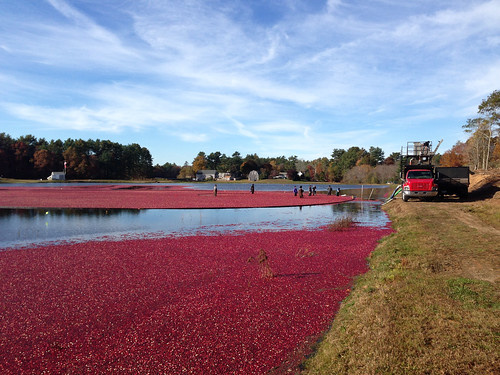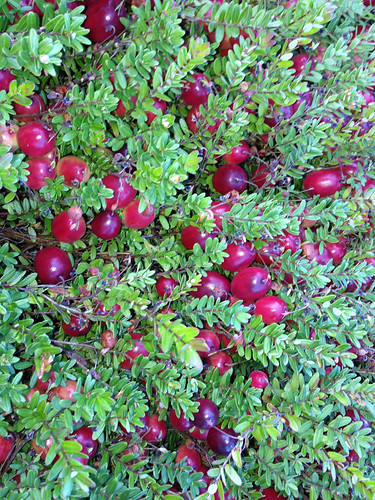
Growers load cranberries after a harvest at Mayflower Cranberries in Plympton, Mass. Photo by Jeff LaFleur of Mayflower Cranberries used with permission.
It’s tough to imagine the Thanksgiving celebration without turkey, dressing, and most importantly, the cranberry sauce. To keep this holiday staple safe from the cold and ready for harvest, farmers apply water to cranberries on frosty nights.
USDA’s Natural Resources Conservation Service and Cape Cod Cranberry Growers Association worked with growers to install automated sprinkler systems that conserve water and trim costs.
With the automated system, cranberry growers can control sprinklers from a computer and turn on and off sprinklers with a simple button. Traditionally, the different systems had to be turned on and off manually, wasting time, money and water.
A Conservation Innovation Grant from NRCS has enabled the association to work with 11 growers and implement these sprinkler systems, which are a relatively new technology to the industry.
These systems have sensors among the cranberry vines that monitor temperature and other weather conditions. A grower can monitor and control the systems from the Internet. Growers using these systems can save more than 9,000 gallons of water per acre on a frost night.
“The use of computerized irrigation systems had a huge impact on growers’ lives,” said Jeff LaFleur, the association’s former director. “The system has simplified how we monitor bog temperatures, and it provides accurate data on when irrigations systems should be turned on to protect from frost.”

Sprinklers spray water on cranberries during a frosty morning. Photo by Jeff LaFleur of Mayflower Cranberries used with permission.
During the study period, the systems kept water running about two hours less. For a typical growing season, 280,000 gallons of water per acre can be conserved.
Water protects the plants because as it turns to ice, heat is released, warming the berries. If the berries get too cold, they’re difficult to market.
“Water is our life blood in cranberries,” said LaFleur, who now heads the Massachusetts Association of Conservation Districts and owns his own cranberry farm. “Even though cranberry bogs are dry most of the growing season, proper water management is critical to yields and fruit quality.”
This grant, awarded in 2007, has changed the way cranberry growers do business. The grant shows how technology can make farming easier and cheaper, LaFleur said. Most of the participating growers plan to invest in more automated systems for their bogs.

Cranberries are floated after they are picked. Photo by Jeff LaFleur of Mayflower Cranberries used with permission.
“It was risky for growers to participate in this project,” he said. “We asked them to trust computers and make management decisions based upon what the computers were telling them. The end result is that growers have come not only to trust the systems but rely heavily on them on a regular basis to better manage the resources on their farms.”
Most cranberries are grown in southeastern Massachusetts, where 400 cranberry growing families farm more than 14,000 acres.
Cranberries grow in low-lying beds layered with sand, peat, gravel and clay. Commonly called bogs, they were originally created by glacial deposits. Now, growers create commercial bogs through a network of wetlands, ditches and ponds.
Almost 20 percent of cranberries produced each year are eaten during Thanksgiving week, what LaFleur calls “an iconic part of the Thanksgiving celebration.”

Ripe berries on the vine ready to be picked at Mayflower Cranberries in Plympton, Mass. Photo by Jeff LaFleur of Mayflower Cranberries used with permission.
No comments:
Post a Comment
Note: Only a member of this blog may post a comment.